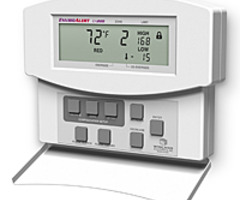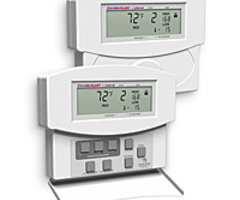Can I Monitor the Temperature of My Pool or Hot Tub With My Alarm System?
Yes, you can monitor the temperature of your pool or hot hub with your alarm system. To do this, you will need a waterproof probe and a programmable temperature sensor. You must connect the waterproof probe to the sensor, and the sensor must be integrated with your security system.

Having your alarm system monitor the temperature of your pool or hot tub requires a fairly intricate setup, but it is possible. Standard temperature sensors are often used with security systems to alert the user to an ambient temperature that is unusually high or low, typically due to a faulty HVAC system. The difference when monitoring the temperature of a pool or hot tub is that you will need a waterproof probe to accurately measure the temperature of the water, rather than the ambient temperature of the air. You will also need a programmable temperature sensor that will allow you to set the permissible temperature range. The idea is that if the detected temperature of the water goes outside the permissible range that has been set, then the temperature sensor will alert your security system, which will in-turn alert you and/or the central station.
When you think about temperature sensors used with alarm systems, they are usually used to monitor the temperature of the air, rather than the temperature of water. Additionally, these sensors don't usually allow the user to set permissible temperature limits. Instead, these devices simply alert the system at predefined limits that cannot be adjusted by the user. On the low end, the minimum allowable temperature before an alert will occur is around 40°F, which gives the user a bit of time before the ambient temperature falls down further to freezing temperatures of 32°F and below. Severe damage can occur if a building's temperature falls down to freezing levels, so it is important that the user has sufficient time to take action in that scenario. But on the high end, the maximum allowable temperature for a non-programmable temperature sensor is usually around 90°F to 95°F. This is well below the temperature that would be detected during a fire, but it is still much higher than almost anyone would keep the inside of their home or office. In that case, the user will know that their HVAC system is experiencing issues that must be fixed.
But when you are monitoring the temperature of a pool or hot tub, then these limits are not very helpful at all. Most pool and hot tub owners like to keep the water's temperature within a much smaller window. For instance, a pool owner might want to keep the water temperature between 70°F and 80°F at all times. A hot tub owner might be even more restrictive, requiring that the water temperature always stays between 98°F and 102°F. There is also the consideration that monitoring water temperature has its own set of challenges that are completely different than monitoring the temperature in the air. Simply put, special equipment is required to make this work. You need a digital temperature sensor where you can set defined temperature limits based on how hot/cold you plan to keep your pool or spa, and you also need a waterproof probe that you can connect to the digital temperature sensor so that the water temperature can be accurately and reliably measured. You must also make sure that the temperature sensor is able to interface with your alarm system so that it can alert you and/or the central station when the detected temperature goes outside the permitted range.
One setup that we have found to work very well is to use a Winland TEMP-L-W Waterproof Temperature Sensor Probe in conjunction with a Winland EA200 EnviroAlert Wired Temperature Sensor. The Winland TEMP-L-W Probe dips into the water to continuously monitor the temperature. The other end of the probe connects with the EA200 unit. You can then set high and low temperature limits on the EA200. If the detected temperature goes outside the defined limits, then the EA200 can alert your system so that a response can occur. You can find detailed information on how to wire and setup the EA200 here. You will need to find a way to integrate the EA200 with one of your system's zones. Many users with wireless systems will connect the Winland EA200 to a compatible wireless transmitter so that the module can interface with one of the wireless zones on the system. Make sure to choose a transmitter based on the wireless frequencies that are accepted by your system. Remember that you will also need a power supply and backup battery to keep the EA200 running. Other waterproof temperature probe and digital programmable temperature sensors may work as well, but the Winland EA200 and Windland TEMP-L-W combo is great if you are looking to do your shopping on the Alarm Grid website.
Did you find this answer useful?
We offer alarm monitoring as low as $10 / month
Click Here to Learn MoreRelated Products


Related Categories
- Answered

